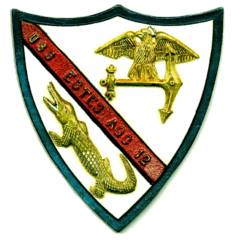
USS ESTES
AGC-12
USS ESTES ASSOCIATION
HOME PAGE
![]()
|
|
USS ESTES
AGC-12 |
|
![]()
![]()
|
While at Icy Cape, there was an interruption in the daily routine of sailors aboard the various ships. From San Francisco and the major press associations, news was received aboard the flagship that a truce had been signed in Korea. It was good news. Almost to the man, sailors of Task Force Nine had served in the Far East, and participated in the Korean war. Ten days were spent at Icy Cape, waiting for the word that the ice further north had opened a channel through which the ships could proceed. When the word, "Now go to your stations all the special sea and anchor details," was passed over the public address system on July 31st, it meant our "wait" was over. The ships maneuvered through scattered blocks of ice to Wainwright, arriving there the same day for a one night's stay. Leaving Wainwright, August 1st, our next destination, Point Barrow was but a short distance away. The ship arrived there August 2nd. Despite the careful planning and skillful predictions of the weathermen on board the flagship, Mother Nature had the last word at Point Barrow. A sudden shift in the winds, from south to northwest, shoved the big chunks of the polar ice against the ships anchored off Point Barrow. Within a matter of hours, the ice surrounded the ships making it impossible for them to get underway. Ice clogged the screws of the vessels and soon it was risky business to maneuver through the cluttered sea. Speculation aboard the flagship mounted as Bluejackets recalled some of the "sea stores" they had heard about other mariners who had spent an Alaskan winter or two aboard ships frozen still in the Arctic ocean. Some of the stories were false, others were true. For example, in 1903, a Norwegian skipper, Captain Roald Amundsen spent three successive winters in Alaska aboard his ship, the auxiliary sloop, GJOA, frozen helplessly to the sea. No such disaster appeared imminent when, on August 4th, the ships one by one maneuvered free of the ice under their own power. Skilled seamen were standing-by, however, and alternate plans were tried before the ships were able to get underway. A tow line was rigged between the Northwind and the Electra now only feet from being aground. The Estes' helicopter, operating from the Northwind carried the "messenger" between the two ships. A second plan was tried before the Estes cleared the ice. Skilled seamen from the ice-breaker crossed the ice afoot, carrying a line between the Northwind and the Estes. They climbed over the ice, packing along a small boat which they paddled between the solid ice floes. Neither plan was successful. When the job was done, Rear Admiral Frederic S. Withington, Task Force Commander, issued a message to the crew congratulating them for their splendid teamwork and a job "well done." Captain Holtwick, commanding officer of the Estes also congratulated the crew. His praise, like that of the admiral, was relayed to the crew over the ship's general announcing system.
For most of the crewmen on board the ships of Task Force Nine, this was their first trip across the Arctic Circle. It was a trip filled with work, adventure and surprise. Best of all, it offered a chance to get better acquainted with America's last frontier and a chance to learn more about the people of the Far North. In the Arctic, it was learned that this part of the world is largely populated by the Native Eskimo who has borrowed ideas from the white man, yet retained of his original culture. These Natives, as sailors discovered, are gifted with intelligence and ingenuity. And they display a friendly attitude toward the visiting white man--whether he has taken permanent residence among them, as have some of the government workers, or merely among them for a few days as were members of the Advance Party from the Task Force. Barrow, facing the Arctic ice packs, is an important trading center for the entire Arctic coast that stretches 450 miles eastward. To the left is Siberia while on its right is Arctic Canada and Greenland. When viewed from this vantage point, it can be seen that Alaska is not an "isolated country" Alaska is only 18 hours direct flying from Yokohama or New York. And Central Europe is but a day away by air. Some of the sailors believed--before visiting the Arctic--that the further north you went, the colder it would be. Though it was plenty cold during parts of this trip, these Bluejackets learned the Arctic Region is warmed by the heat from the ocean radiated through the floating ice. It was a surprise to some to learn that thousands of square miles in Alaska's lowlands--to the south--are actually colder than Point Barrow. |